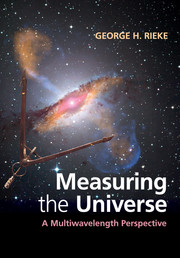Book contents
- Frontmatter
- Contents
- Preface
- 1 Radiometry, optics, statistics
- 2 Telescopes
- 3 Detectors for the ultraviolet through the infrared
- 4 Optical and infrared imaging; astrometry
- 5 Photometry and polarimetry
- 6 Spectroscopy
- 7 Adaptive optics and high-contrast imaging
- 8 Submillimeter and radio astronomy
- 9 Interferometry and aperture synthesis
- 10 X- and gamma-ray astronomy
- 11 Epilogue: cosmic rays, neutrinos, gravitational waves
- Appendix A Useful constants
- Appendix B Common Fourier transforms and relations
- References
- Index
- References
Preface
Published online by Cambridge University Press: 05 November 2012
- Frontmatter
- Contents
- Preface
- 1 Radiometry, optics, statistics
- 2 Telescopes
- 3 Detectors for the ultraviolet through the infrared
- 4 Optical and infrared imaging; astrometry
- 5 Photometry and polarimetry
- 6 Spectroscopy
- 7 Adaptive optics and high-contrast imaging
- 8 Submillimeter and radio astronomy
- 9 Interferometry and aperture synthesis
- 10 X- and gamma-ray astronomy
- 11 Epilogue: cosmic rays, neutrinos, gravitational waves
- Appendix A Useful constants
- Appendix B Common Fourier transforms and relations
- References
- Index
- References
Summary
Preface
Progress in astronomy is fueled by new technical opportunities (Harwit, 1984). For a long time, steady and overall spectacular advances in the optical were made in telescopes and, more recently, in detectors. In the last 60 years, continued progress has been fueled by opening new spectral windows: radio, X-ray, infrared (IR), gamma ray. We haven't run out of possibilities: submillimeter, hard X-ray/gamma ray, cold IR telescopes, multi-conjugate adaptive optics, neutrinos, and gravitational waves are some of the remaining frontiers. To stay at the forefront requires that you be knowledgeable about new technical possibilities.
You will also need to maintain a broad perspective, an increasingly difficult challenge with the ongoing explosion of information. Much of the future progress in astronomy will come from combining insights in different spectral regions. Astronomy has become panchromatic. This is behind much of the push for Virtual Observatories and the development of data archives of many kinds. To make optimum use of all this information requires you to understand the capabilities and limitations of a broad range of instruments so you know the strengths and limitations of the data you are working with.
- Type
- Chapter
- Information
- Measuring the UniverseA Multiwavelength Perspective, pp. xi - xiiPublisher: Cambridge University PressPrint publication year: 2012



